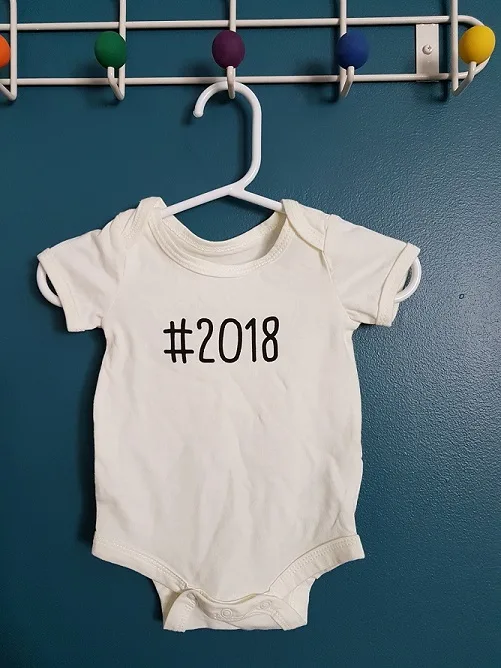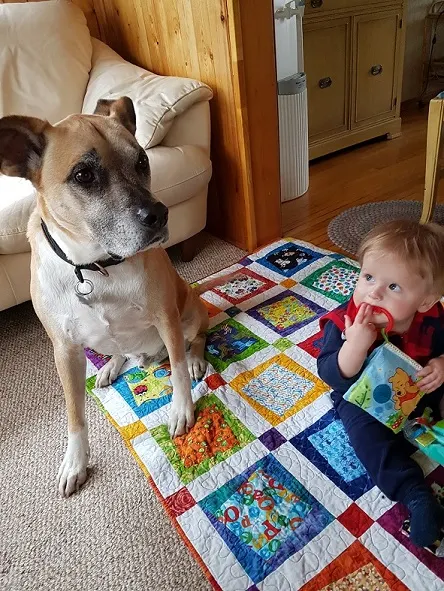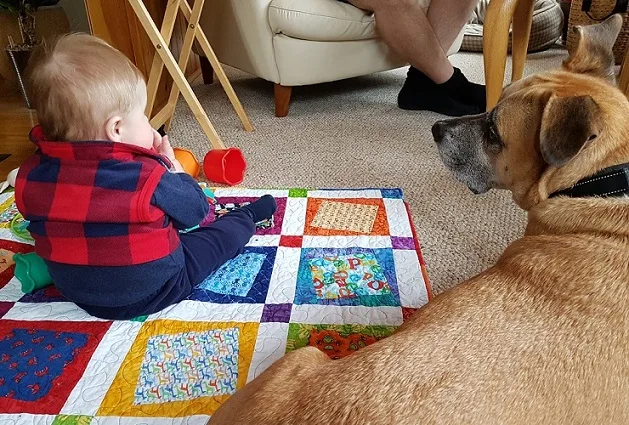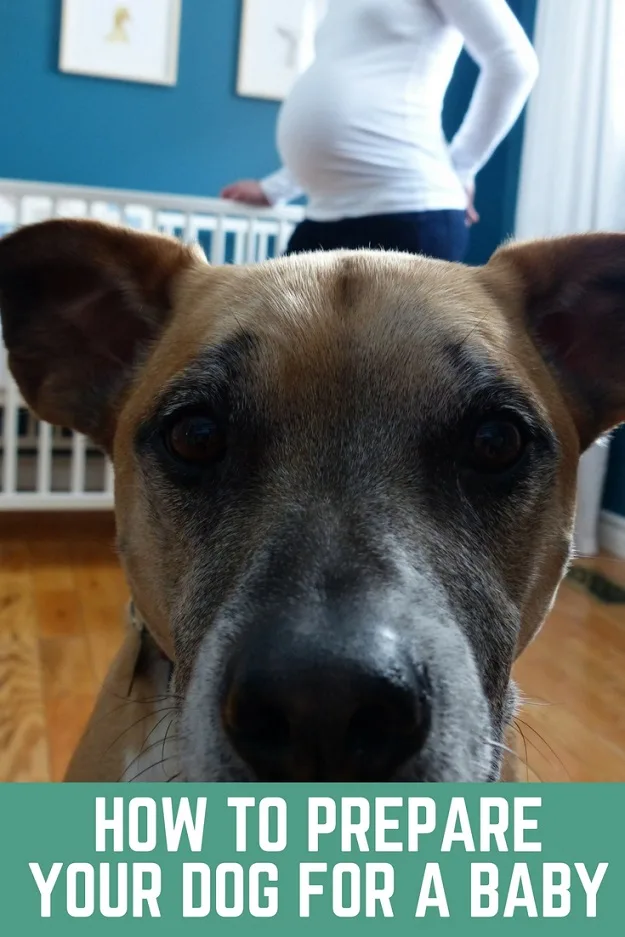Thanks everyone for all of your good wishes on the news of our expanding family. It’s an exciting time for our whole household.
I really want to make sure that we set our dog Baxter up well for this new addition. He’s a big part of our family and this will be a big change for all of us.
One of my first steps in preparing Baxter for the baby was talking and meeting with our trainer. If you are adding a baby to your life, I would encourage you to consult a professional trainer. Our trainer has been helpful throughout the whole time we’ve had Baxter, and her insights now are very encouraging.
How to Prepare Your Dog for a Baby
My plan for preparing Baxter for the arrival of the new baby can be summed up in three words: safe, happy, respect.
- Safe – For baby and dog. No biting, jumping or chasing. No pulling leashes, ears, tails or fur. Everyone feels safe and is safe.
- Happy – Dog, baby, parents are relaxed together. Everyone gets enough care, stimulation and variety (this goes for Mama and Daddy too).
- Respect – Dog and baby are both members of this family. They have their own spaces, their own food, their own toys. Everyone can be together, but they also have their own areas if they need to be alone.

I’m touching on a few specifics for our training below, but this post is the kickoff to a series of more in-depth articles on each topic. As we publish new posts, we’ll link to them here so you can read all the entries in the series. In subsequent posts, I’ll dive more deeply into each topic.
Current posts in this series:
1. Who will care for your dog on delivery day?
2. How to change your dog’s routine in advance
3. New sights, sounds and smells
4. The birth announcement!
5. Creating safe spaces for dog and baby
6. The official meet and greet
7. Dog toys vs. baby toys
8. Learning to walk with the stroller
9. Car rides with dog and baby
10. What we’ve learned + resources
We also have some Q&A posts with other bloggers on how to prepare your dog for a new baby:
To start off, I want to share a bit of background on Bax’s experience and attitude with children:
Preparing your dog for your baby – know your dog
Baxter joined our family four and a half years ago when he was 3 years old. We don’t know very much about his living situation before he joined his foster family. I have no idea about his experience with children.
Baxter lived in a foster home for three weeks with lots of small children, and he did fine with everyone as far as we heard and saw.
Since living with us, Baxter’s exposure to children has been minimal. We have nieces and nephews, but they’re not in his life every day. In Bax’s case, absence did not make the heart grow fonder.
He has become a bit uncertain around some children. What we’ve learned is Baxter thinks infants are boring and toddlers are a bit freaky.
Babies get sniffed and then Baxter will lay down and doze—his normal routine. He’s not watchful, even if there is crying or other sounds.
When the baby is a bit bigger and sitting on his own, Baxter has been content to hang around and relax.

Once babies start walking, Baxter becomes more watchful. He doesn’t like certain small people coming up to him or wanting to pet him. He will go up to them and sniff and tolerate being petted, but it’s on his terms.
It also depends on the child. We have two nephews who are both 4 years old. They have very different energy levels, and Baxter reacts differently to each of them.
It’s important that Baxter feels like he has a clear escape route when kids are around. He does pretty well with kids outside. But iinside or anywhere he feels more trapped, he sometimes will growl to let us know he’s had enough.
Growling is good. It lets us know he’s uncomfortable and we can address the situation. Growling is communication, not aggression. When Baxter growls, we can remove him (or the child) from the situation, redirect them and everyone carries on.
Growling aside, we overall have a very easy going, low-energy, lazy dog. I’m hoping that attitude will give us a good foundation with our new baby. Our trainer was encouraging because she said Baxter will have time to get used to the baby at various stages.
However, I don’t want to completely rely on my dog’s easy-going nature. I can’t assume everything is going to be OK. So I came up with a list of things we’ve been working on to prepare Baxter for baby.
How to prepare your dog for a baby – what to think about
Preparing for dog care on your delivery day
It’s important to have a plan in place for dog care on your baby’s delivery day. This is especially helpful in case of emergency or if things don’t go as planned. As our baby’s due date approaches, I want to have a reliable and flexible plan to make sure Baxter is taken care of.
I listed written and digital instructions for Baxter’s care. I also have a bag packed with all his belongings such as food, bowls and a toy. For the most part, everything is ready to make things as easy as possible for Baxter’s pet sitters.
Read more about preparing for dog care on your delivery day here.
Your dog and baby’s routines and schedules
Baxter is a dog of routine. I’d like any changes to our daily schedule to be in place well before baby arrives. We will make sure Baxter gets his meals, walks and bathroom breaks as needed. We will also figure out who’s doing what in advance.
For more details: How to change your dog’s routine.
How to get your dog used to baby sights, sounds and smells
From crying to lotions to a play mat on the floor, the baby is going to bring new things to our home. I hope that introducing these to Baxter before the baby arrives will give him fewer changes to process at once. Read more here.
How to make sure your dog has his own space
Our baby and our dog need their own spaces and we need to teach them to respect each other’s space. We’re thinking in advance about how we’re going to handle floors, rooms, beds and other furniture. We’ll decide what’s going to be shared or not. Read more here.

Dogs toys vs. baby toys!
Baxter loves his stuffed animals, and the baby has already built up quite a collection as well. Figuring out how to keep the toys separate and accessible for everyone and avoid any squabbles is an important goal. Read more here.
Training your dog to walk with a stroller
Baxter is pretty good on leash, but a stroller adds a different element. We’re practicing with an empty stroller now. That way, when baby, Bax and I all go for a walk we can do it safely. Read more here.
Car rides with your dog and baby
Mr. B loves having the back seat all to himself. He can move around and look or sniff out the window as much as he wants. But for the first little while at least, Bax is going to be riding in the back of the car. This may be more about training me to get over my guilt that he can’t sniff out the window. Read more here.
How to introduce your dog to your baby
We will carefully plan for the first… and likely second, third and fourth… interactions between Baxter and our baby. This will help ensure that Baxter’s experiences with the baby are good right from the start.
Update: Read about their first greeting.

I hope this is an interesting and helpful series on how to prepare your dog for a baby.
Do you have any tips or questions on how to prepare your dog for a baby?
Let us know in the comments!
Julia Preston writes for That Mutt about dog behavior and training, working dogs and life on her farm in Ontario, Canada. She has a sweet, laid-back boxer mix named Baxter. She is also a blogger at Home on 129 Acres where she writes about her adventures of country living and DIY renovating.

Jem Horwood
Wednesday 27th of June 2018
This is so clever. I have never had a dog and a baby at the same time, so I've never really thought about all these issues. It is interesting to hear you say that growling is good. We've started putting Bear in a separate room on the three times a year that my students come en masse. He just doesn't do well with the young ones anymore, gets very nervous. I think it's an age thing. After one unfortunate incident, we just keep them apart.
S
Monday 12th of February 2018
Have a go to trick that he can do at a distance. This is useful when you want to give the dog a positive activity but don’t want him on top of you. Stash treats in easy to reach spots so you can toss them to him if his behavior is good. For example, baby is fussing, your stress is rising, pup is getting nervous, you say a quick sit, reward, praise, he relaxes.
Julia at Home on 129 Acres
Monday 19th of February 2018
Thanks for the tips. One of the books I read recommended stashing treats in a variety of spots around the house just for those types of situations.
Barbara Rivers
Friday 2nd of February 2018
This sounds like it's going to be a very interesting series with actionable advice - nice! Three of my daily dog walking clients had their first babies last year, and all of them made sure to talk to me (in my capacity as their dog walker/pet sitter) well in advance to make sure I'd be available to care for their pups on and around delivery day. Made everything smoother and less stressful on all parties involved :)
Julia at Home on 129 Acres
Friday 2nd of February 2018
That's great that you were able to be there for them at this important time. Our D-Day plan is coming up.
KL
Wednesday 31st of January 2018
I am so glad to see you say "growling is good."
I don't have kids so no experience with readying my dog for a resident child, but I have purposely never extinguished her growl. I know people who sharply correct growling. I want that warning in place, instead of a dog who goes right to acting.
Julia at Home on 129 Acres
Wednesday 31st of January 2018
Absolutely. The growl is a warning and then I can deal with the situation before it escalates. And also learn so that I can try to create more positive situations in the future that don't make my dog uncomfortable.